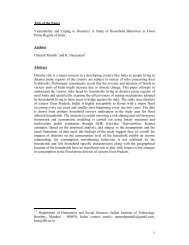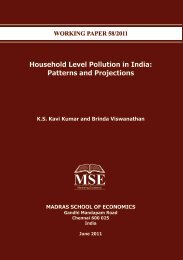Discount Rate for Health Benefits and the Value of Life in India
Discount Rate for Health Benefits and the Value of Life in India
Discount Rate for Health Benefits and the Value of Life in India
Create successful ePaper yourself
Turn your PDF publications into a flip-book with our unique Google optimized e-Paper software.
As expected, <strong>the</strong> effect <strong>of</strong> life years lost (longevity) variable is<br />
negative <strong>and</strong> statistically significant at 1 per cent level <strong>in</strong> both columns,<br />
provid<strong>in</strong>g a strong support <strong>for</strong> <strong>the</strong> life cycle model <strong>of</strong> <strong>in</strong>ter temporal<br />
choice. The estimated real discount rate us<strong>in</strong>g (6) is approximately equal<br />
to 3.0 per cent <strong>in</strong> column 1 <strong>and</strong> 2.7 per cent <strong>in</strong> column 2 <strong>of</strong> table 3.<br />
There<strong>for</strong>e, we can reject both extreme alternative hypo<strong>the</strong>ses that <strong>the</strong><br />
<strong>India</strong>n workers exhibit a zero rate <strong>and</strong> an <strong>in</strong>f<strong>in</strong>ite rate (i.e., workers are<br />
myopic) when mak<strong>in</strong>g <strong>the</strong> valuation <strong>of</strong> <strong>the</strong>ir future health risks. The bank<br />
<strong>in</strong>terest rate on fixed deposits given by private people <strong>in</strong> <strong>India</strong> was 12<br />
percent <strong>in</strong> 1990. However, <strong>the</strong> <strong>in</strong>terest rate that <strong>India</strong> has to pay on<br />
external loans (i.e., <strong>the</strong> average <strong>in</strong>terest rate on debt to private creditors<br />
such as <strong>the</strong> World Bank) was only 8 percent <strong>in</strong> <strong>the</strong> same year. Thus, <strong>the</strong><br />
estimated real rate is lower than <strong>the</strong> nom<strong>in</strong>al <strong>in</strong>terest rate on external<br />
debt <strong>and</strong> bank rate <strong>for</strong> fixed deposits. If we allow a 4 per cent <strong>in</strong>flation<br />
rate, our estimated real rate is closer to <strong>the</strong> real rate on external debt.<br />
The equation (5) is essentially a l<strong>in</strong>ear dem<strong>and</strong> curve <strong>for</strong><br />
longevity, where <strong>the</strong> implicit price <strong>of</strong> longevity is a decl<strong>in</strong><strong>in</strong>g function <strong>of</strong><br />
<strong>the</strong> quantity dem<strong>and</strong>ed. Us<strong>in</strong>g a will<strong>in</strong>gness to pay (WTP) approach, we<br />
can calculate <strong>the</strong> value <strong>of</strong> longevity by summ<strong>in</strong>g <strong>the</strong> area under this<br />
dem<strong>and</strong> curve as shown <strong>in</strong> Figure 1. The WTP <strong>for</strong> longevity T0 is:<br />
V(T)=T0(�W/�p(T0))+(1/2)T0(�W/�p(0)–(�W/�p(T0)) (7)<br />
Us<strong>in</strong>g <strong>the</strong> coefficients <strong>in</strong> column 1 (column 2) <strong>of</strong> table 3 <strong>and</strong> <strong>the</strong><br />
average values <strong>of</strong> <strong>the</strong> explanatory variables given <strong>in</strong> table 1, <strong>the</strong> implicit<br />
price when T=0 (i.e., ∂Y/∂p(0)) equals 0.1769 (0.1696 <strong>in</strong> column 2) <strong>and</strong><br />
when T0=25 equals 0.102 (0.0996). These values can be substituted <strong>in</strong><br />
(7) to get <strong>the</strong> amount that a worker is will<strong>in</strong>g to sacrifice which is<br />
approximately 5.35 (5.10) rupees <strong>in</strong> hourly wages <strong>for</strong> a risk exposure <strong>of</strong><br />
25 additional years <strong>of</strong> life. In terms <strong>of</strong> annual premium with a present<br />
value, <strong>the</strong> same worker would accept Rs. 10720 (Rs. 10230) <strong>for</strong> putt<strong>in</strong>g<br />
25 years <strong>of</strong> longevity at risk. The worker with a risk exposure <strong>of</strong> one<br />
15



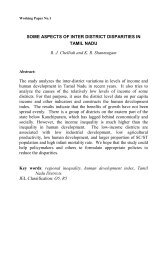
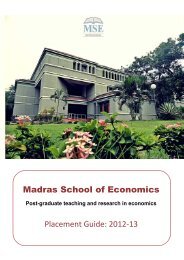
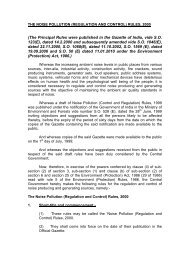
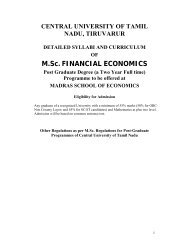
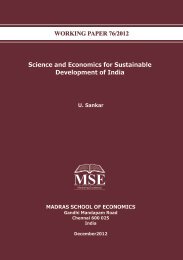
![Curriculum Vitae [pdf] - Madras School of Economics](https://img.yumpu.com/49878970/1/190x245/curriculum-vitae-pdf-madras-school-of-economics.jpg?quality=85)
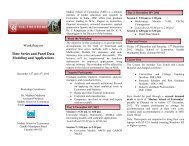
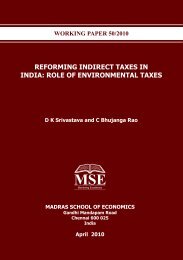
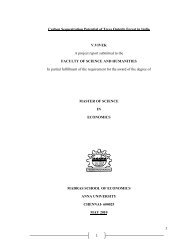
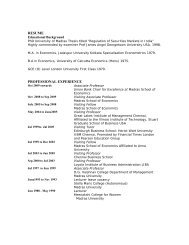
![Curriculum Vitae [pdf] - Madras School of Economics](https://img.yumpu.com/48715201/1/184x260/curriculum-vitae-pdf-madras-school-of-economics.jpg?quality=85)
